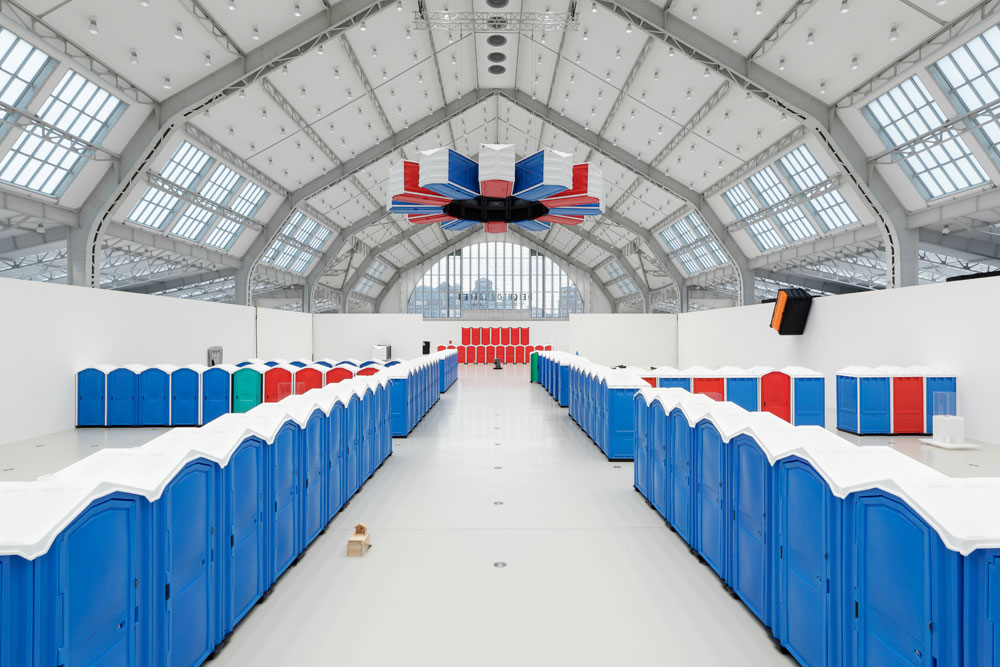Andreas Slominski
Deichtorhallen, Hamburg, Germany
Deichtorhallen, Hamburg, Germany

This spring, following a five-year hiatus, Maurizio Cattelan announced his return to art making. A founder of Toilet Paper magazine, the artist installed a working 18-carat gold toilet at New York’s Guggenheim Museum (with the help of private donors). Though Cattelan chose not to elaborate on the meaning of the work – titled America – its form, material and high-profile launch completed a century-old heroic trilogy: Duchamp, 1917 – Manzoni, 1961 – Cattelan, 2016.

Cattelan’s bawdy gesture at the Guggenheim contrasts nicely with Andreas Slominski’s current exhibition at Hamburg’s Deichtorhallen, ‘Das Ü des Türhüters’ (‘The O of the Door’), as here, too, the exhibition employs a toilet motif. Yet contra Cattelan’s gold, Slominski works with portable latrines, commonly known as Portaloos, and unlike the Italian provocateur, Slominski sprints away from art history and art gags, into the contradictory and unglamorous present.
At the Deichtorhallen, phalanxes of red and blue toilet cabins stand in military precision in the main hall (Untitled, 2016), as if transplanted from an outdoor event. At one end of the hall is a double row of portaloos stacked in a honeycomb pattern (Rote Mauer, Red Wall, 2016), and more of them hang as a mighty chandelier from the five-metre ceiling (Untitled, 2016). The exhibition is quiet apart from the regular slamming of the door on a single toilet steadily rotating around its own axis on a wall above the parade (Big Ben, 2016).

In a second area containing smaller works, Slominski presents reliefs made from the same plastic used for the portaloos, but stamped with kitschy, ‘artistic’ motifs: a toilet-shaped palette, brushes, an easel, combined with lettering or icons of saints. In other works normally hidden technical elements of the toilets have been surgically removed (e.g., Gurgel, Gullet, 2016), and crocheted protective covers for toilet rolls make an appearance (Kniebank, Kneeler, Bundesliga, both 2016). The last time I had seen such a doily it was on the back shelf of a Trabi – that classic East German car – in the mid 1980s. Considering that Slominski grew up in northwest Germany, close to the German border with the Netherlands, I was struck by the question: was this typically East German equivalent of a nodding dog in fact a petit-bourgeoisie affectation found on both sides of the Iron Curtain?
Slominski turns material this way and that, dismantling and reassembling it with rigour, stamina and analytical fervour. One of the portaloos is displayed horizontally, so you can see into the darkness of its bowl (Die Nacht, The Night, 2016). But what’s his fascination with toilets? Are these plastic shells perhaps simply an architectural tool to tame the Deichtorhallen’s huge space? For an artist, who came to prominence as a setter of traps, was he perhaps fascinated by his own deep fear of these facilities: getting stuck inside one and going unnoticed for a period? Or was it just the pleasure of imagining Hamburg’s aging art-lovers spending time in a portaloo on a Friday afternoon musing over its sculptural qualities?

Most of the toilets are closed, but some can be entered. Some – their bowl removed and a second door added – can even be walked through (Portal, 2016). Disconnected from its usual outdoor settings, in this pristine environment – the exhibition is spotless, including the disconnected, trunk-like waste pipe that hangs limply across one of the show’s walls (saugen, suck, 2016) – one can concentrate fully on the portable toilet’s peculiar mix of cheap, interchangeable, plastic that seems both shameful and slightly repulsive (and, in times of makeshift refugee housing, maybe even political). Slominski has, in the past, placed urine-covered bananas on a museum windowsill but there’s no olfactory dimension here – that would be too cheap. In its cold, industrialized dealing with the disposal of human waste, it’s all the more unsettling.






















